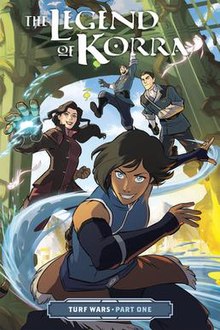
Avatar: The Last Airbender, also known as Avatar: The Legend of Aang in some regions, is an American anime-influenced animated television series produced by Nickelodeon Animation Studios. It was co-created by Michael Dante DiMartino and Bryan Konietzko, with Aaron Ehasz serving as head writer. It aired on Nickelodeon for three seasons, from February 2005 to July 2008.
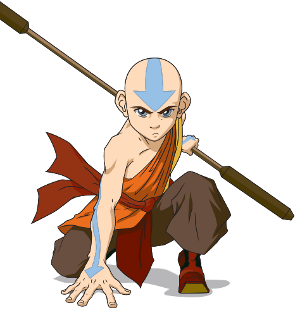
Avatar Aang is the title character and protagonist of Nickelodeon's animated television series Avatar: The Last Airbender, voiced by Zach Tyler Eisen. Aang is the last surviving Airbender, a monk of the Air Nomads' Southern Air Temple.
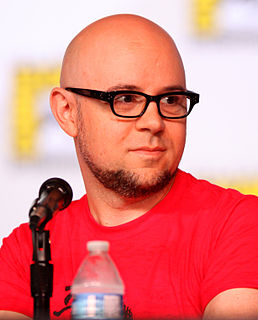
Michael Dante DiMartino is an American animator, producer, writer, and director. He is best known, together with Bryan Konietzko, as the co-creator of the animated TV series Avatar: The Last Airbender and The Legend of Korra, both on Nickelodeon.

Bryan Konietzko is an American animator, writer, producer and musician. He is best known, together with Michael Dante DiMartino, as the co-creator and executive producer of the animated series Avatar: The Last Airbender and The Legend of Korra.

The Legend of Korra, also known as Avatar: The Legend of Korra, is an American anime-influenced animated television series created by Michael Dante DiMartino and Bryan Konietzko for Nickelodeon. A sequel to DiMartino and Konietzko's previous series Avatar: The Last Airbender, which aired from 2005 to 2008, the series ran for 52 episodes ("chapters"), separated into four seasons ("books"), from April 14, 2012, to December 19, 2014. It has been continued as a comics series.

Avatar Korra is the title lead character in Nickelodeon's animated television series The Legend of Korra, in which she is depicted as the current incarnation of Raava's Avatar—the spiritual embodiment of balance and change—responsible for maintaining peace and harmony in the world. She is the immediate reincarnation of Avatar Aang. The character was created by Michael Dante DiMartino and Bryan Konietzko and is voiced by Janet Varney, and by Cora Baker as a child.
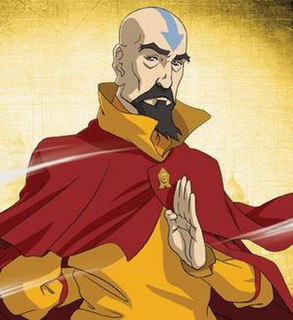
Tenzin is a major character in Nickelodeon's animated television series The Legend of Korra, which aired from 2012 to 2014. The character and the series, a sequel to Avatar: The Last Airbender, were created by Michael Dante DiMartino and Bryan Konietzko. He is voiced by J. K. Simmons. Tenzin's father, Aang, was the Avatar who preceded Korra and kept world peace by preventing the Fire Nation from taking over the world during the Hundred Year War, which occurred about seventy years before the beginning of The Legend of Korra. Tenzin's mother, Katara, greatly assisted Aang in his efforts to save the Earth Kingdom from destruction. Tenzin is the youngest of the three children of Aang and Katara.
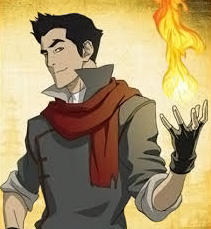
Mako is a major character in Nickelodeon's animated television series The Legend of Korra, which aired from 2012 to 2014. The character and the series, a sequel to Avatar: The Last Airbender, were created by Michael Dante DiMartino and Bryan Konietzko. He is voiced by David Faustino. Because he is a firebender, Mako is able to create and manipulate the classical element of fire. Mako also has the ability to both generate and redirect lightning. The character was named in honor of the late Mako Iwamatsu who voiced Iroh, a major supporting character, in the first two seasons of Avatar: The Last Airbender.

Bolin is a major fictional character in Nickelodeon's animated television series The Legend of Korra, which aired from 2012 to 2014. The character and the series, a sequel to Avatar: The Last Airbender, were created by Michael Dante DiMartino and Bryan Konietzko. He is voiced by P. J. Byrne. Bolin is able to manipulate the classical element of earth, which is known as earthbending. It is revealed in the third season that he is also able to create and control lava, which is a very rare sub-ability called lavabending.

The Avatar: The Last Airbender comics are an official continuation of the original Nickelodeon animated television series, Avatar: The Last Airbender, created by Michael Dante DiMartino and Bryan Konietzko. The series includes The Lost Adventures, published from 2005 to 2011 and set between episodes of the original series, and the graphic novel trilogies, published since 2012 and set a few years after the original series. A related comic continuation, taking place seven decades later, The Legend of Korra, began publication in 2017.

The third season of the animated television series The Legend of Korra, titled Book Three: Change, was created by Michael Dante DiMartino and Bryan Konietzko, and consists of thirteen episodes ("chapters"), all animated by Studio Mir. The season began airing on Nickelodeon in the U.S. on June 27, 2014. After leaked episodes and following declining ratings, the series stopped airing on Nickelodeon after episode 8 on July 25, 2014. Episodes 9 to 13 of Book Three were subsequently made available on the Internet weekly through Nickelodeon's website and on digital download platforms.
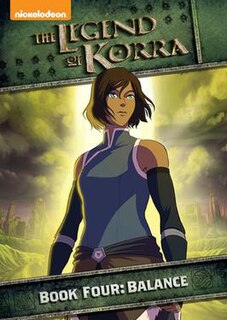
Book Four: Balance is the fourth and final season of the animated television series The Legend of Korra by Michael Dante DiMartino and Bryan Konietzko. It consists of thirteen episodes ("chapters"), all animated by Studio Mir. The episodes were made available on the Nickelodeon website and other online outlets each Friday beginning on October 3, 2014 and premiered on Nicktoons on November 28, 2014. Critical reception of Book Four, as of the series in general, was positive.
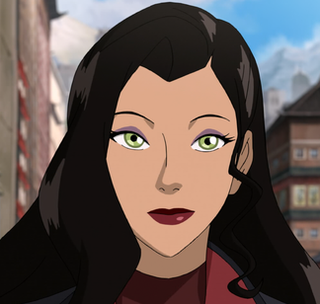
Asami Sato is a major character in the Nickelodeon animated television series The Legend of Korra, which aired from 2012 to 2014. The character and the series, a sequel to Avatar: The Last Airbender, were created by Michael Dante DiMartino and Bryan Konietzko. She is voiced by Seychelle Gabriel. The series' final scene, indicating the beginning of a romantic relationship between Asami and the female lead character, Korra, was unprecedented in its representation of LGBT persons in western children's television.
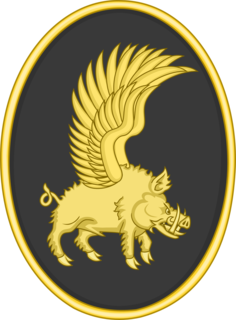
Lin Beifong is a major character, voiced by Mindy Sterling, in Nickelodeon's animated television series The Legend of Korra, which aired from 2012 to 2014. The character and the series, a sequel to Avatar: The Last Airbender, were created by Michael Dante DiMartino and Bryan Konietzko. Lin's mother, Toph Beifong, greatly aided the previous avatar, Aang, in his efforts to save the Earth Kingdom from destruction. Lin is the older of Toph's two daughters.
The Legend of Korra comics are a continuation of the Nickelodeon animated television series The Legend of Korra, created by Michael Dante DiMartino and Bryan Konietzko. It is set after the series finale, and follows Avatar Korra and Asami Sato on their relationship. The comics are published by Dark Horse Comics, alongside Avatar: The Last Airbender.
General Kuvira is a fictional character in the Nickelodeon animated television series The Legend of Korra, created by Michael Dante DiMartino and Bryan Konietzko. Introduced in a minor capacity in the third season of the series, she becomes the main antagonist of the fourth season and a protagonist of the Ruins of the Empire comics. Kuvira was created with similar characteristics to the portrayal of protagonist Korra in prior seasons to highlight the changes she had made over the course of the series. Kuvira's character has been mostly met with positive reception. Critics note her motives as being understandable, while her actions are given political analogues.
Irene Koh is a comics artist from Seoul, South Korea. She has previously worked with large comics publishers like Dark Horse Comics, DC Comics, and Marvel Comics. She was the main artist for Turf Wars trilogy of The Legend of Korra comics.

The Legend of Korra: Ruins of the Empire is a three-part graphic novel series written by Michael Dante DiMartino, with art by Michelle Wong. The series was first announced in October 2018 as a three-part extended sequel to The Legend of Korra: Turf Wars, with the story centering on Avatar Korra and her allies as they deal with the fallout of Kuvira's surrender in the Earth Kingdom. Avatar Korra's romantic relationship with her close longtime friend Asami is also further explored in the series.

Avatar: The Last Airbender is an American multimedia franchise consisting of two animated television series, a live-action film, comics, books, video games, home media, and soundtracks. The franchise began with the animated television series Avatar: The Last Airbender, which aired on Nickelodeon from 2005 to 2008. The series is set in an Asian-inspired fantasy world in which some people can telekinetically manipulate one of the four classical elements: air, water, earth or fire. Only the titular "Avatar" can bend all four elements and is responsible for maintaining balance in the world.
